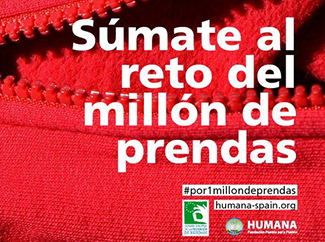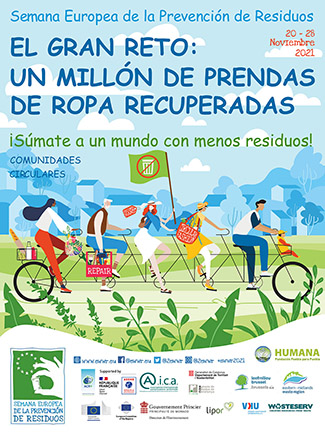consent_cookie
Duración: 1 year
Stores the user's cookie consent state
16-11-2021
Recover a million items of clothing in just 9 days to avoid the emission of 1,000 tons of CO2 during that period. This is the challenge Humana faces during the European Week for Waste Prevention, which takes place from 20 to 28 November.
For the third year, the Foundation takes on this challenge to contribute to the prevention of waste and give a second life to textile waste through reuse or recycling.
Circular community, sustainable community and zero waste
The aim of the European Week for Waste Reduction, which is supported by the LIFE + program of the European Commission, is to organize awareness-raising actions on waste prevention throughout the same week. On each occasion a thematic day is held and in this 13th edition we want to focus on the binomial circular community, sustainable community and joint work for a Planet that achieves zero waste.
“The thematic focus refers to the need for individual citizens and the wider community to get involved, invest and see the local value and benefits in pursuing zero-waste and circular activities. The promotion of the circular economy and a zero-emission society will require a change in consumption and production patterns that go far beyond climate action, ”say the organizers.
In this context, Humana promotes "The challenge of a million garments" during this event that begins next Saturday the 20th. The delegations of the entity will turn to, during the European Week, citizens deposit the clothes, footwear and accessories that they are no longer used at any of the 5,000 collection points (containers on public roads and secondhand Humana stores).
Results from previous years
In the last two editions, donations have exceeded 900,000 pieces of clothing, so the collection action has fallen short of meeting the challenge. The European Week for Waste Reduction is a good opportunity to promote sustainable actions and raise awareness about waste prevention and reuse.
The recovery of one million items of clothing would prevent the emission of at least 1,000 tons of CO2 during the period in which the Week is celebrated. A report by the European Commission indicates that each kg of clothing that has a second life and does not end up in a landfill to be incinerated avoids the emission of 3,169 kg of CO2.

